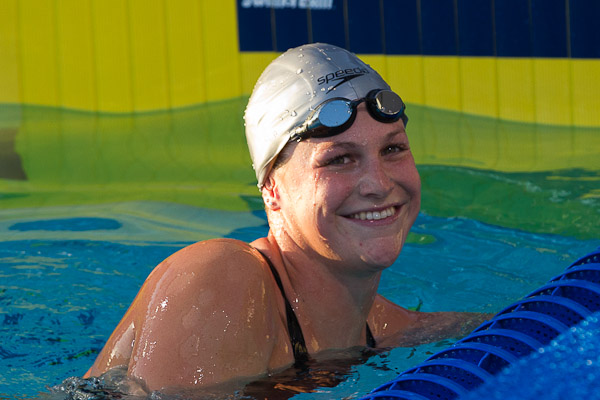 |
| You would be smiling too if you'd dropped as much time |
What impresses me more than anything about McKeever's Cal teams over the last decade is development of talent. The current Cal star, swimmer of the meet Caitlin Leverenz, is a great example. It's easy to look now and say "Of course she's fast! Look at that talent.". However, when Caitlin Leverenz entered college, it was not a foregone conclusion that she would be an NCAA star. Leverenz had a huge breakout year at 15 years old, and then sputtered a little over the next two years. She was particularly far from the short course swimmer she is now: her SCY bests in her three stellar events from this past weekend were as follows:
200 IM: 1:57.97
400 IM: 4:06.69
200 Br: 2:08.22
Consider that over the weekend, Leverenz was more than six seconds faster than that in the 200 IM alone. That kind of improvement is impressive for any female college swimmer, much less one that entered as fast as Leverenz was. In this way, Leverenz performances mirrors that of the star of Cal's past: Natalie Coughlin.
Coughlin too, entered college with considerable talent, but with a swimming career that had stalled a bit after looking very promising. At Cal, she became the best female swimmer in the world, which again looking back seems like a foregone conclusion even though it most certainly wasn't. My point is that there are swimmers like Coughlin and Leverenz entering college every year, super talented but not having fully realized it. The batting average for coaches with these athletes is very low: McKeever's is much higher.
So how does she do it? I'll admit the following is pure speculation, based primarily on having heard McKeever speak both formally and informally. I believe that McKeever manages confrontation like no other coach I've ever met. What I mean by "confrontation" is the art of speaking with an athlete, conveying what they have to do to improve, and then moving forward from it together with them. This can be incredibly hard with any athlete, but is much harder the more success they have already had. Success is confirmatory: athletes start to set in stone some of the processes they used to achieve it. However, further improvement requires change- so you can't set things in stone.
Last year in San Diego, McKeever gave a couple anecdotes that I believe showed her ability to confront. Because the theme of her talk was team building, she focused on examples that involved her entire team, not individuals, although I'm sure many of the same principles apply. McKeever lined up all the swimmers on her squad and told them they had 30 seconds, without speaking, to make a line with the best swimmer at the front, and the worst at the back.
When I retell McKeever's anecdote, all coaches have the same reaction: their eyebrows raise as they think about doing it with their own team. It sounds like a recipe for total chaos and strife. I can only assume, based on her results, that McKeever has the skill to talk her athletes through the aftermath. After all, it is important for athletes to know where they stand. The exercise is brilliant: but executing it correctly takes a ton of skill.
In much the same way, it takes skill to sit an athlete down and tell them what they need to improve, and actually have them leave just as invested as you are. It's a skill that many other coaches have a lot of room for improvement on if they want to catch the Bears.

I feel the same way. I was so impressed with her last year in San Diego, and I loved the example you gave. I was going to try it with my team last season but I chickened out. She's really got it rolling right now.
ReplyDeleteShe's been one of my favorite coaches for the past 7 or 8 years. I just like her no-BS approach. Her people skills is what really impressed me. Aside from Mike Bottom she is one of those coaches I can't listen to enough. In the end, I like how she is into building character--as these athletes take with them the lessons learned under her watch.
ReplyDeleteInteresting.
ReplyDeleteLook at what Steve Bultman is doing at Texas A&M is doing with so-called less heralded recruits.